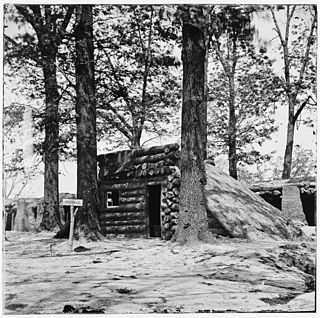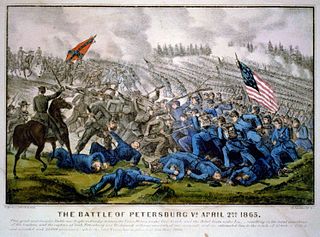
The Battle of Fort Stedman, also known as the Battle of Hare's Hill, was fought on March 25, 1865, during the final weeks of the American Civil War. The Union Army fortification in the siege lines around Petersburg, Virginia, was attacked in a pre-dawn Confederate assault by troops led by Maj. Gen. John B. Gordon. The attack was the last serious attempt by Confederate troops to break the Siege of Petersburg. After an initial success, Gordon's men were driven back by Union troops of the IX Corps commanded by Maj. Gen. John G. Parke.

The Third Battle of Petersburg, also known as the Breakthrough at Petersburg or the Fall of Petersburg, was fought on April 2, 1865, south and southwest Virginia in the area of Petersburg, Virginia, at the end of the 292-day Richmond–Petersburg Campaign and in the beginning stage of the Appomattox Campaign near the conclusion of the American Civil War. The Union Army under the overall command of General-in-Chief Lieutenant General Ulysses S. Grant, launched an assault on General Robert E. Lee's Confederate Army of Northern Virginia's Petersburg, Virginia, trenches and fortifications after the Union victory at the Battle of Five Forks on April 1, 1865. As a result of that battle the Confederate right flank and rear were exposed. The remaining supply lines were cut and the Confederate defenders were reduced by over 10,000 men killed, wounded, taken prisoner or in flight.
The 54th Pennsylvania Volunteer Infantry was an infantry regiment which served in the Union Army during the American Civil War.

The 1st Michigan Sharpshooters Regiment was an infantry regiment that served in the Union Army's Army of the Potomac during the American Civil War.

The 53rd Pennsylvania Volunteer Infantry was a volunteer infantry regiment in the Union Army during the American Civil War.

John Lilley was a United States soldier who was recognized with his nation's highest award for valor, the U.S. Medal of Honor, for his gallantry during the American Civil War. While fighting with Company F of the 205th Pennsylvania Infantry as part of the Union Army engaged in the Third Battle of Petersburg, Virginia on April 2, 1865, he captured the flag of the Confederate States Army by single-handedly rushing, and forcing the surrender of, that army's color-bearer, along with several additional CSA soldiers.
The 60th Ohio Infantry Regiment was an infantry regiment in the Union Army during the American Civil War.
The 87th Pennsylvania Volunteer Infantry was an infantry regiment that served in the Union Army during the American Civil War.

The 138th Regiment, Pennsylvania Volunteer Infantry was an infantry regiment that served in the Union Army during the American Civil War.
The 18th New Hampshire Infantry Regiment was an infantry regiment that served in the Union Army during the American Civil War.

The 93rd Pennsylvania Volunteer Infantry was an infantry regiment that served in the Union Army during the American Civil War.
The 102nd Pennsylvania Volunteer Infantry was an infantry regiment that served in the Union Army during the American Civil War.

The 50th Regiment Pennsylvania Volunteer Infantry was an infantry regiment that served in the Union Army during the American Civil War.

The 100th Regiment Pennsylvania Volunteer Infantry was an infantry regiment that served in the Union Army during the American Civil War.
The 51st Pennsylvania Volunteer Infantry was an infantry regiment that served in the Union Army during the American Civil War.
The 41st United States Colored Infantry was an infantry regiment that served in the Union Army during the American Civil War. The regiment was composed almost entirely of African American enlisted men and commanded by white officers. The regiment was authorized by the Bureau of Colored Troops which was created by the United States War Department on May 22, 1863. The regiment engaged in the Siege of Petersburg and Appomattox Campaign and was present at the unconditional surrender of Confederate General Robert E. Lee and the Army of Northern Virginia at Appomattox Court House on April 9, 1865.
The 200th Pennsylvania Volunteer Infantry was an infantry regiment that served in the Union Army during the American Civil War.

The 211th Regiment Pennsylvania Volunteer Infantry was an infantry regiment of the Union Army in the American Civil War. Raised in western Pennsylvania in September 1864, the regiment initially served with the Army of the James during the Siege of Petersburg, holding trenches at Bermuda Hundred. In late November it transferred to the Army of the Potomac and during the northern hemisphere spring campaign fought in the counterattack during the Battle of Fort Stedman and the Union breakthrough at Petersburg. During the last days of the Appomattox Campaign it guarded trains, and participated in the Grand Review of the Armies following the end of the war before mustering out.

The 199th Regiment Pennsylvania Volunteer Infantry, alternately known as the Commercial Regiment, was an infantry regiment of the Union Army in the American Civil War. Raised in Philadelphia in late 1864, the regiment enlisted for one year and was sent to the Army of the James during the Siege of Petersburg. During the Third Battle of Petersburg it assaulted Forts Gregg and Alexander, then pursued the retreating Confederate Army of Northern Virginia, fighting at Rice's Station and Appomattox Court House. Following the Confederate surrender at Appomattox, the regiment moved to Richmond, where it mustered out in late June 1865.

The 207th Regiment Pennsylvania Volunteer Infantry was an infantry regiment of the Union Army in the American Civil War. Raised mostly in northern and central Pennsylvania in mid-1864, the regiment initially served with the Army of the James during the Siege of Petersburg, holding trenches at Bermuda Hundred. In late November it transferred to the Army of the Potomac and during the northern hemisphere spring campaign fought in the counterattack during the Battle of Fort Stedman and the Union breakthrough at Petersburg. During last days of the Appomattox Campaign it guarded the supply line, and participated in the Grand Review of the Armies following the end of the war before mustering out.












